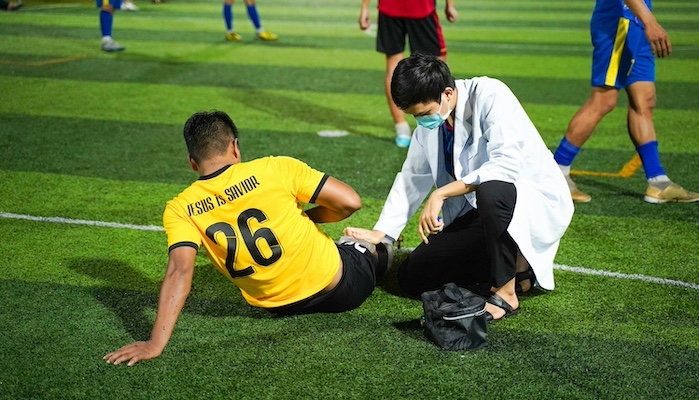
Soccer is a popular sport that can lead to various injuries, ranging from minor ankle sprains that may sideline players for a couple of weeks to more severe injuries like ankle fractures or ACL tears, which can take months to heal.
The increasing popularity of highly competitive and physically demanding play, particularly among children and teenagers, has increased injury rates. Below, you will find information on injury prevention, common soccer-related conditions, and different treatments for players.
Soccer Injury Prevention – Get in Shape
Soccer requires both aerobic (endurance) and anaerobic (strength) fitness. Maintaining a high level of conditioning in both areas is crucial because the sport is physically challenging. Playing soccer once or twice a week without engaging in other fitness activities can increase the risk of injury. Effective aerobic conditioning can include activities such as running, cycling, or using the elliptical machine.
In addition to aerobic fitness, incorporating a strengthening regimen is highly recommended. This can include resistance training with weights, Pilates, and yoga. Core strengthening focusing on the body's trunk is often overlooked but equally essential.
While stretching hasn't been definitively proven to prevent injuries, it is widely considered to offer general benefits, such as improving range of motion, and flexibility, reducing soreness, and aiding in recovery.
Common Soccer Injuries
Soccer injuries frequently affect the lower body, from the hips down to the toes. Injuries to the head and face are the second most common, with back-related issues ranking third.
Soccer-related injuries can be either sudden and traumatic or result from overuse. While collisions are often unavoidable, many injuries can be prevented by understanding and adhering to the rules of the game. Two critical rules to reduce injury risk are avoiding contact from behind and keeping elbows below shoulder height when interacting with opponents.
Head injuries, such as concussions, are rarely caused by heading the ball. More commonly, they occur from collisions with another player or impacts with the ground or goalpost.
Lower Extremity Injuries
Injuries below the waist, such as knee ligament tears, can occur both from contact and non-contact situations. Most anterior cruciate ligament (ACL) tears, for example, are non-contact injuries and occur due to "cutting" movements (side-to-side motions) or improper landings after a jump. ACL injuries are more common in female athletes. Prevention exercises and specialized programs, like the HSS Sports Safety ACL Program, can help protect players from knee injuries by educating coaches, parents, and athletes through hands-on training.
Other common lower body injuries include ankle sprains and muscle strains. Using ankle braces or proper taping techniques can improve stability and reduce injury risks without negatively affecting performance. Strained muscles often occur in the calf, hamstrings, quadriceps, or groin. To prevent strains, maintaining general conditioning and following a proper warm-up routine is critical. A good warm-up should include soccer-specific activities such as light jogging, kicking, and gradually progressing to sprinting.
Overuse Injuries
Overuse injuries can result from repetitive "micro-trauma," leading to conditions like tendonitis or stress fractures. These injuries typically occur due to poor conditioning or overtraining when athletes push themselves beyond their physical limits. To avoid these injuries, it’s essential to include at least one or two days of non-impact activities each week, especially if training daily.
Precision Pain Care and Rehabilitation has two convenient locations in Richmond Hill – Queens, and New Hyde Park – Long Island. Call the Queens office at (718) 215-1888 or (516) 419-4480 for the Long Island office to arrange an appointment with our Interventional Pain Management Specialists, Dr. Jeffrey Chacko or Dr. Sonny Ahluwalia.















